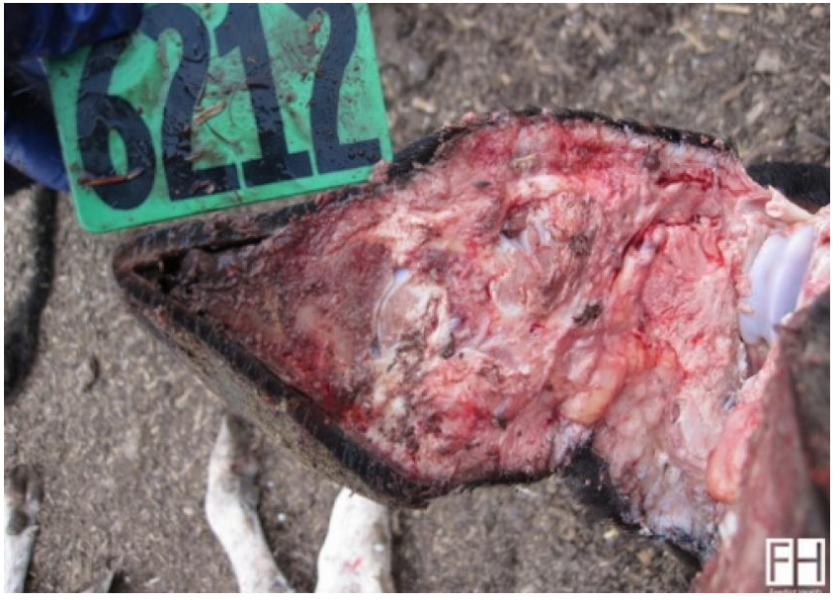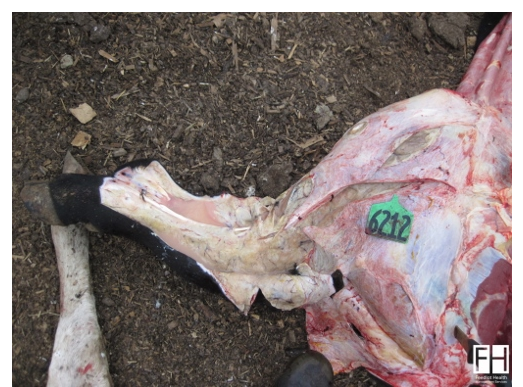Post-Mortem reveals Toe Tip Necrosis Syndrome

These images show a yearling heifer that died at 19 days on feed after having been treated for signs of lameness two days prior to death.
The team at Feedlot Health Management Services diagnosed this case as toe tip necrosis syndrome (TTNS), a disease process characterized by necrosis of the third phalangeal bone (P3).
PATHOGENESIS
The prevailing hypothesis is that P3 necrosis begins with damage to the hoof’s white line following excessive toe-tip wear after transportation, or handling events on abrasive flooring like concrete or gravel. Bacteria then colonize P3 by migrating across the damaged apical white line.
EPIDEMIOLOGY
• Most often develops early in the feeding period, within days to weeks of handling or transportation.
• Anecdotally, observed more commonly in cattle that become easily agitated, but can develop in all placement types.
• Occurs during all months of the year.
ANTE-MORTEM CLINICAL SIGNS
• Lower limb lameness with no evidence of other diseases such as foot rot, digital dermatitis, or injury.
• Most commonly affects the lateral claws of the hind feet giving affected animals a “cow-hocked” appearance as the try to shift weight to the medial claws of the hind feet.
• Close examination of the lame foot may demonstrate toe-tip abrasions, white line separation, draining tracts above the coronary band, and, in severe cases, a sloughed hoof wall.
MANAGEMENT
• Management is often limited to antimicrobial therapy and supportive care such as housing animals in well bedded pens with easy access to feed and water while limiting handling across rough surfaces.
• Debridement and/or claw amputation may be attempted; however, data on the effectiveness of these procedures are limited.
• If severe “outbreaks” are occurring, investigation into management practices and facilities are warranted to reduce potential risk factors.
• Humane euthanasia of severe cases is often necessary.
POST-MORTEM LESIONS
• Avascular necrosis of the soft tissues at the toe tip – dark, typically liquefactive necrosis (Fig. 1, lead photo).
• After opening the claw with a saw or axe, necrosis of P3 is evident with or without a pathologic fracture.
• Cellulitis/fasciitis can be present in chronic cases, extending retrograde from the affected hoof and possibly continuing to the subcutaneous tissues of the abdomen and thorax (Fig. 2 above).
• Bacteremia sequelae such as embolic pneumonia may be present in chronic cases.
This article was first published in April 2019. The Post-Mortem Series presented in partnership with Feedlot Health Management Services, Okotoks, Alberta. For more information, visit their website at www.feedlothealth.com.
Working with crews at client operations, Feedlot Health conducts post-mortem exams on all feedlot and calf-grower mortalities, using a standard protocol for recording the animal’s history, digital images, and post-mortem findings. The group compiles images and post-mortem findings in a central database, for review by the professional team, as an educational tool and to track disease trends within an operation or across their client base.








